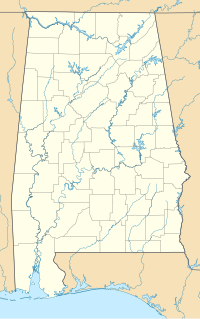Gee's Bend, Alabama
| Boykin, Alabama | |
|---|---|
| Census-designated place | |

Rear view of the detached kitchen and former plantation home of the Mark Pettway family, called Sandyridge, in Boykin during April 1937. The house was demolished a short time later. Photographed by Arthur Rothstein.
|
|
| Location within the state of Alabama | |
| Coordinates: 32°4′42.08″N 87°16′49.33″W / 32.0783556°N 87.2803694°WCoordinates: 32°4′42.08″N 87°16′49.33″W / 32.0783556°N 87.2803694°W | |
| Country | United States |
| State | Alabama |
| County | Wilcox |
| Area | |
| • Total | 2.672 sq mi (6.92 km2) |
| • Land | 2.660 sq mi (6.89 km2) |
| • Water | 0.012 sq mi (0.03 km2) |
| Elevation | 128 ft (39 m) |
| Population (2010) | |
| • Total | 275 |
| • Density | 100/sq mi (40/km2) |
| Time zone | Central (CST) (UTC-6) |
| • Summer (DST) | CDT (UTC-5) |
| ZIP code | 36723 |
| Area code(s) | 334 |
Boykin, also known as Gee's Bend, is an African American majority community and census-designated place in a large bend of the Alabama River in Wilcox County, Alabama. As of the 2010 census, its population was 275. The Boykin Post Office was established in the community in 1949 and remains active, servicing the 36723 ZIP code.
Gee's Bend was named for Joseph Gee, an early large land owner from Halifax County, North Carolina who settled here in 1816. Gee brought 18 African American slaves with him and established a cotton plantation within the bend.
Boykin is a block of land enclosed on three sides by the Alabama River, within a horseshoe shaped turn of the river named Gee's Bend. It is within the Black Belt of Alabama. The plantation started by Joseph Gee passed to his nephews Sterling and Charles Gee upon his death, along with 47 slaves. The brothers then sold it to their relative Mark H. Pettway in 1845 to settle a $29,000 debt. About a year later, the Pettway family moved from North Carolina to Gee's Bend, bringing about one hundred slaves with them. When slavery was abolished many of them continued working for the Pettways as sharecroppers. Many of the black tenants Arthur Rothstein photographed were named Pettway. The white Pettway family owned the property until 1895, when it was sold to Adrian Sebastian Van de Graaff. Van de Graaff, a lawyer from Tuscaloosa, then operated it as an absentee landlord.
The Resettlement Administration reports of the 1930s emphasized the isolation of the community, describing the unreliable ferry that approached from the east and the muddy road that entered from the west. The community had received public assistance from the Red Cross in 1932 and federal and state aid in 1933 and 1934. Beginning in 1935, the Resettlement Administration made agricultural loans and offered farm and home management advice. In 1937, the average rural rehabilitation loan to Gee's Bend families was $353.41, and the agency reports speak of possible cooperative undertakings; a building campaign for houses, barns, a schoolhouse, and a sawmill. Residents were also encouraged to replace oxen with more efficient mules.
...
Wikipedia


